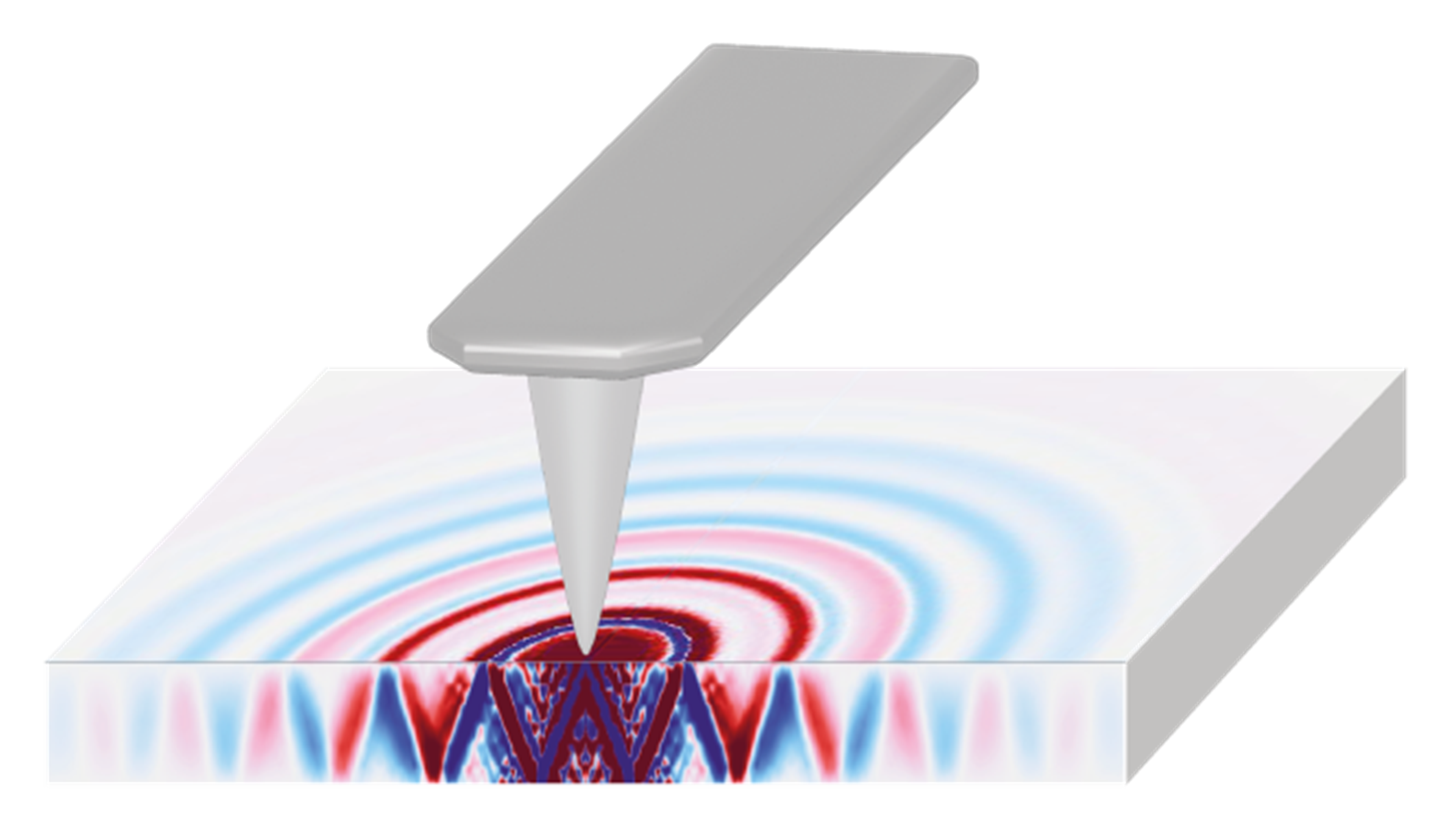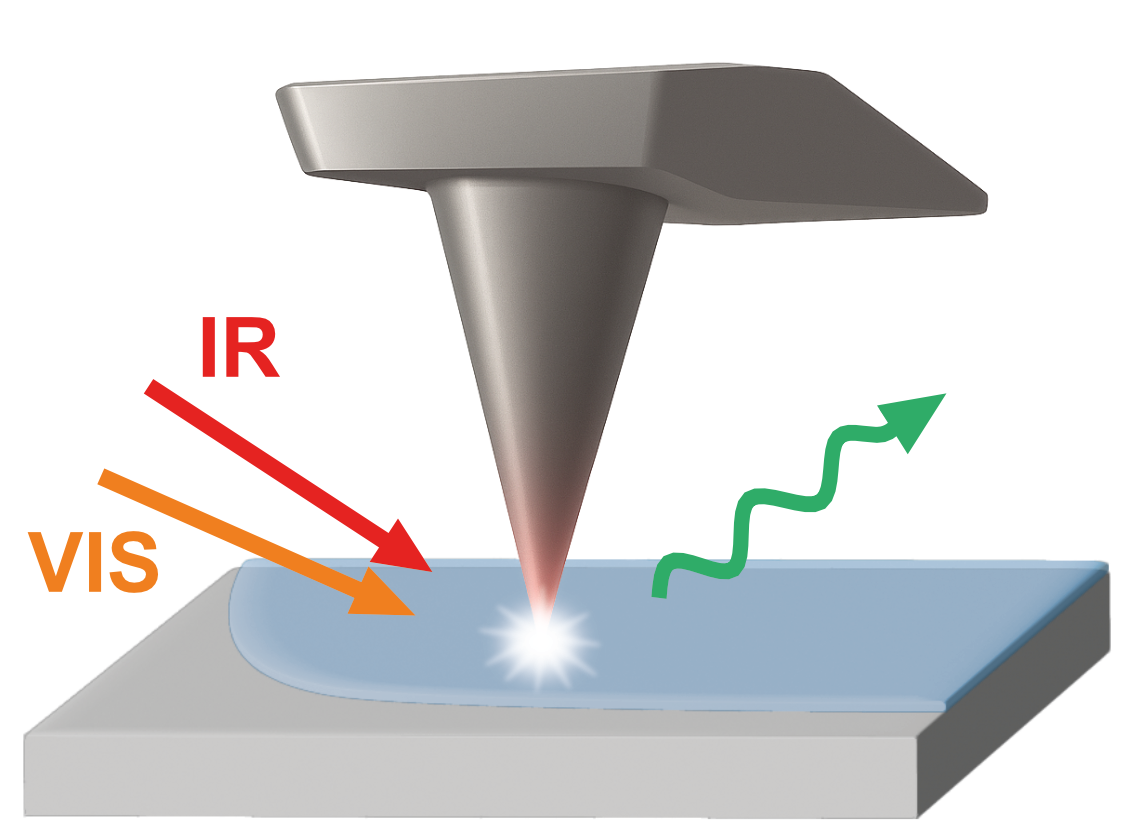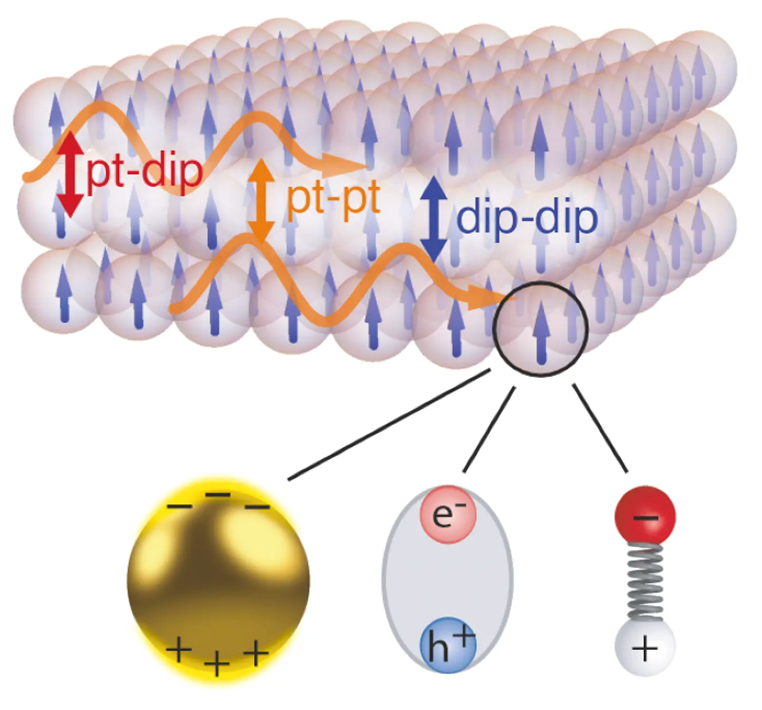Research
Our group investigates nanoscale light-matter coupling phenomena in quantum materials. We use polaritons to shrink light to the nanoscale and employ ultrafast nonlinear optical techniques to bridge phenomena in the typically separate mid-infrared and visible spectral ranges. We aim to advance the understanding of interfaces in 2D quantum materials, activate new coupling channels to convert light between different spectral ranges, and engineer materials through hybrid light-matter states. Our research is funded by the Emmy Noether Programme of the German Research Society (DFG). We closely collaborate with research groups at the department, the neighboring Fritz Haber Institute, and partners around the world.
Polaritons
Polaritons are hybrid light-matter quasiparticles that enable the confinement of light to the nanoscale, far beyond the diffraction limit. They emerge when photons strongly couple with material excitations—such as plasmons, excitons, or phonons—forming mixed states that share properties of light and matter. Over the past decades, polaritons have revolutionized nanophotonics, paving the way for nanoscale waveguides, ultrasensitive optical sensors, and novel light sources. We are particularly interested in phonon polaritons, which can compress long-wavelength terahertz and mid-infrared light down to the nanoscale. The inherent optical anisotropy of many solid-state materials leads to fascinating light behaviors, including directional ray-like propagation and hyperlensing. To investigate these effects, we employ scanning near-field optical microscopy (SNOM), nonlinear optical microscopy and numerical modeling. We actively search for new materials to expand both the functionality and the spectral reach of polaritonic systems.

Selected publications:
Optical Anisotropy of 2D van der Waals Materials
chapter in F.J. García de Abajo et al. Roadmap for Photonics with 2D Materials
N.S. Mueller, A. Paarmann, P. Alonso-González, A.Y. Nikitin, A. Alú, T. Low, V. Volkov, L. Martín-Moreno, and J.D. Caldwell
arXiv 2504.04558 (2025)
Ultraconfined THz Phonon Polaritons in Hafnium Dichalcogenides
R.A. Kowalski*, N.S. Mueller*, G. Álvarez-Pérez, M. Obst, K. Diaz-Granados, G. Carini, A. Senarath, S. Dixit, R. Niemann, R.B. Iyer, F.G. Kaps, J. Wetzel, J.M. Klopf, I.I. Kravchenko, M. Wolf, T.G. Folland, L.M. Eng, S.C. Kehr, P. Alonso-Gonzalez, A. Paarmann, and J.D. Caldwell
arXiv 2502.09909 (2025)
Nonlinear Optical Microscopy and Upconversion
Nonlinear optical processes are powerful tools to probe symmetry breaking in low-dimensional materials and convert light between different spectral ranges. We are particularly interested in sum-frequency generation (SFG), where ultrafast mid-infrared and visible laser pulses are combined to produce higher-energy photons. In recent projects with advanced SFG microscopes developed at the Fritz Haber Institute (Paarmann, Thaemer and Fellows groups), we imaged infrared material excitations with subdiffractional spatial resolution. This included propagation patterns of phonon polaritons, strong coupling in mid-infrared metasurfaces, and crystallographic imaging of hexagonal boron nitride monolayers. As part of the Emmy Noether project, we aim to integrate SFG and related nonlinear processes into a near-field optical microscope, in order to achieve nanoscale spatial resolution. This will enable us to image symmetry breaking in 2D quantum materials as well as the coupling of different material excitations across spectral ranges.

Selected publications:
Full Crystallographic Imaging of Hexagonal Boron Nitride Monolayers with Phonon-Enhanced Sum-Frequency Microscopy
N.S. Mueller*, A.P. Fellows*, B. John, A.E. Naclerio, C. Carbogno, K. Gharagozloo-Hubmann, D. Baláž, R.A. Kowalski, H.H. Heenen, C. Scheurer, K. Reuter, J.D. Caldwell, M. Wolf, P.R. Kidambi, M. Thämer, and A. Paarmann
arXiv 2504.15939 (2025)
Spectroscopic and Interferometric Sum-Frequency Imaging of Strongly Coupled Phonon Polaritons in SiC Metasurfaces
R. Niemann*, N.S. Mueller*, S. Wasserroth, G. Lu, M. Wolf, J.D. Caldwell, and A. Paarmann
Advanced Materials 36, 2312507 (2024)
Ultrastrong Light-Matter Coupling
In the ultrastrong coupling (USC) regime, the light-matter interaction becomes so strong that it approaches or surpasses the excitation energy of the material itself. This opens the door to new physics, including vacuum-induced material modifications and quantum phase transitions. While USC has traditionally been studied in cavity quantum electrodynamics, we find that many excitations in solid-state and self-assembled materials—such as phonon-, exciton-, and plasmon-polaritons—naturally enter this regime without external cavities. In such systems, light becomes an integral part of the material’s ground state. We investigate USC in these materials with microscopic theories and are working toward experiments to engineer material properties through the hybridisation with light.

Selected publications:
Ultrastrong Light-Matter Coupling in Materials
N.S. Mueller, E.B. Barros, and S. Reich
arXiv 2505.06373 (2025)
Deep Strong Light-Matter Coupling in Plasmonic Nanoparticle Crystals
N.S. Mueller, Y. Okamura, B.G.M. Vieira, S. Juergensen, H. Lange, E.B. Barros, F. Schulz, and S. Reich
Nature 583, 780-784 (2020)